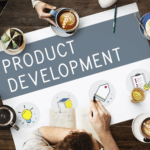Behind every innovative product that hits the market lies a powerhouse team working with laser-sharp focus. These aren’t just employees—they’re specialists who live and breathe new product development (NPD). They take ideas from rough concepts to refined, market-ready products.
So, who are the people working exclusively on NPD efforts? And why do their specialized roles matter so much in driving innovation?
Whether you’re a startup on your first product journey or an enterprise scaling your next big idea, understanding the roles behind successful product launches is your first strategic move.
The Movers and Makers: Who Powers Product Innovation?
Developing a new product is never a solo mission. It’s a team sport, powered by experts from different disciplines. Let’s unpack the core roles that shape the NPD landscape.
1. Product Managers: The Strategic Navigators
Product managers are the architects of product vision. They keep the entire development process aligned with business goals, customer needs, and market trends.
According to McKinsey, companies with strong product management functions are 30% more likely to launch successful products.
From building roadmaps and managing timelines to cross-functional coordination and stakeholder communication, PMs are the force that keeps development focused and forward-moving.
2. Product Designers: Transforming Concepts Into Experiences
Designers don’t just make things look good—they make them feel right. They take abstract ideas and turn them into intuitive, visually compelling products. Forrester reports that good design can boost conversion rates by up to 200%.
Designers collaborate closely with engineers and PMs to build prototypes, test usability, and refine interfaces. Their job is to balance form and function, ensuring the product delights users.
3. Engineers: The Technical Backbone
Engineers are the hands-on builders. Whether it’s code, circuitry, or hardware, they make ideas work in the real world. Harvard Business Review found that better collaboration between designers and engineers can cut development time by 20%.
Their tasks range from writing software to solving mechanical challenges, all while ensuring the product is scalable, safe, and market-ready.
4. Market Research Analysts: Champions of the Customer Voice
These professionals dive deep into consumer behavior, trends, and preferences to guide product direction. They validate ideas before development begins—saving time, money, and effort.
Nielsen data shows that 59% of ideas validated by research have higher success rates.
Their insights shape everything—from feature prioritization to pricing strategy.
5. From Prototype to Production
Once the product design is locked, it’s time to bring it to life at scale. That’s where manufacturing experts step in. They focus on material sourcing, process optimization, and quality control.
Gartner found that companies that streamline manufacturing cut time-to-market by 25%.
This role is key to transforming prototypes into polished, high-quality products without breaking the bank.
-
Quality Assurance (QA) Specialists: The Last Line of Defense
QA professionals test and retest to ensure products meet reliability and quality standards. They catch issues before customers do. According to Statista, nearly half (48%) of product returns are due to quality concerns.
They ensure your product isn’t just functional, but flawless.
7. Marketing & Sales: Early Involvement, Lasting Impact
While not traditionally part of the product development core, marketing and sales teams should be looped in from day one. Their insights shape product positioning, target audience strategy, and go-to-market execution.
HubSpot research shows that products with early marketing input are 33% more likely to succeed.
Why Cross-Functional Teams Win
Successful NPD doesn’t happen in silos. It thrives in cross-functional environments where experts collaborate seamlessly.
PwC reports that cross-functional teams are 2.5x more likely to deliver high-impact results.
This collaboration accelerates innovation, reduces friction, and brings more holistic products to market.
When Collaboration Fails: Communication Pitfalls
Let’s face it—cross-team collaboration can get messy. Differing priorities, miscommunication, and unclear expectations can delay launches or derail projects.
Harvard Business Review found that 60% of product failures stem from poor interdepartmental communication.
The solution? Regular check-ins, aligned KPIs, and a shared understanding of the end goal.
What Makes a New Product Development Team Successful?
Let’s break down the winning ingredients:
Specialized Teams > Generalists
While generalists offer flexibility, NPD demands deep, role-specific expertise. McKinsey found that companies with specialized teams saw an 18% boost in product success rates.
Resource Allocation Matters
You can’t build a Ferrari on a bicycle budget. Adequate tools, tech, and team bandwidth are non-negotiables. Deloitte reports that 72% of companies that properly fund NPD achieve their product goals.
Innovation Is Everything
Standing outtakes bold thinking. While risky, innovation is what turns good products into iconic ones. Bain & Company found that innovation-led companies are 3.5x more competitive.
Project Management Tools Keep It All Together
From Trello to Jira to Asana, these tools prevent bottlenecks and help manage workflows, timelines, and team responsibilities.
Smartsheet reports that teams using PM tools are 20% more productive.
In-House vs. Outsourced NPD: Which One Wins?
Outsourcing Pros:
- Access to niche expertise
- Cost savings for specialized tasks
McKinsey reports that 70% of companies outsource at least part of NPD.
In-House Pros:
- Greater control
- Stronger cultural alignment
- Faster decision-making
Blended Approach: Many modern businesses blend both, keeping strategy and ownership in-house while outsourcing design, dev, or research phases. It’s efficient and scalable.
Real-World Examples: NPD in Action
Apple – Every detail of their product development is handled in-house. This tight control over design, engineering, and production fuels their consistent innovation.
Procter & Gamble – A masterclass in collaboration, P&G connects research, design, and engineering with razor-sharp market insights to launch high-performing consumer products.
Final Thoughts:
New product development is a complex, high-stakes process. But with the right team, tools, and strategy, it becomes a launchpad for business growth.
From vision-setting to market research to quality control—every role plays a part in shaping products that resonate, sell, and endure.
- If you’re seeking a reliable partner in your product journey, BrandNewMD is your go-to product sourcing company. We help businesses navigate the complexities of development—from prototype to production—so you can focus on what matters most: creating something extraordinary.








